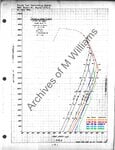- Thread starter
- #101
Yeah, I've run into that at times.Please understand that there are many omissions to meet the 20k character limit
Basically, I was kind of referring to the modification of the rear that sort of blended the taller tailwheel into a tear-drop when retracted.I think there seems no 'special tail wheel faring' for F4U-1 BuNo.17930
This image you posted earlier, but I'll use it for an example...
While this may/may not sound ignorant: I'm curious why they went to the whole trouble of redesigning the whole tailwheel? Was this related to visibility?
What caused there to be such discrepancies between the drag-coefficient chart and the itemized chart that displayed methods to increase speed?Removing the folding mechanism and tail hook, after halves of the doors were bolted closed and the cove for the tail hook was skinned over. the aircraft was to average an increased top speed of 4 mph . . . . Land-based configuration gives additional 4 mph actually for Corsair, there was no additional 6(or 8) mph.
Looking at this image...
Was it possible to fair over any of these plates for an operational aircraft? As for the fairing over the wing-fold line, was this done on land-based aircraft?
Wait, they could have made improvements to the engine cowling?In my view, for estimated +8 mph, smooth and faired cowling would have had a substantial impact.
Actually, even with the 13'1" blade -- it's still supersonic at the tips. It's just not quite as extreme 1.0699 vs 1.0791 within 200 feet of each other in altitude. That said, with the F6F's propeller you're going 6 miles an hour faster at the same altitude.I think Zipper 730's calculation is a good indication of why the early F4U-1's old 13'4" prop was losing efficiency at high altitude high speed range
That would put you about 0.6 mph of 425 mph.In conclusion, the F4U-1 BuNo.17930's 431 mph seems the best performance actually achievable with standard drag condition for standard production F4U-1 with 13'1" prop as Navy stated, even assuming the worst, can subtract up to 6.4 mph.
Critical altitude goes up because you have a lower fuel/air ratio, and it's closer to the stoichiometric ratio for gasoline combustion.F6F-5 BuNo.58310 graph, the auto-lean curve showed faster than the auto rich at altitude, the vmax was about 8 mph faster, and the critical altitude increased about 400 ft
If I read this right, the test involved a 13'0" propeller instead of the F4U-1's 13'4", or the F6F-3's 13'1" design. The gear ratio was also 0.4 instead of 0.5. So the ability to estimate performance to within 500 feet was pretty decent at the time?http://www.wwiiaircraftperformance.org/f4u/f4u-1-02334.pdf
In the F4U-1 BuNo.02334's report, standard F4U-1 expected 404 mph @ 25300' for military power and ACP showed 407 mph @ 24800' actually obtained for military power. this is a fairly close result and seems resonable for Navy's estimate.
To be honest, looking at this image: This seems to fit the F4U-1A/C/D's arrangement pretty good. I would have thought the bubble would have slowed the plane down a bit, not sped it up by 2 mph.



